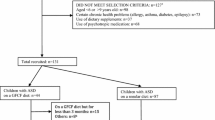Abstract
The children with autism have feeding problems such as chewing, preference for the same food that often are responsible for the nutrient imbalance. In this study, we have analyzed the differences in food consumption (food frequency) and eating behavior (CEBI test) between children with autism and their typically developing peers. A statistically significant difference was observed between the two groups for the consumption of milk, yogurt, pulses, rice, and fruit juices (p ≤ 0,005). We observed a significant difference in the analysis of CEBI results when considering the 6- to 9.5-year-aged subgroup with autism vs control subgroup (103.50 and 110.14, respectively). The advices given by nutritionists have proved crucial to improve eating habits in children with autism, in the follow-up.
Similar content being viewed by others
References
Cornish E (1998) A balanced approach towards healthy eating in autism. J Hum Nutr Diet 11:501–509. doi:10.1046/j.1365-277X.1998.00132.x
Ahearn WH, Castine T, Nault K, Green G (2001) An assessment of food acceptance in children with autism or pervasive developmental disorder-not otherwise specified. J Autism Dev Disord 31(5):505–511. doi:10.1023/A:1012221026124
Marshall J, Hill RJ, Ziviani J, Dodrill P (2013) Features of feeding difficulty in children with autism spectrum disorder. Int J Speech Lang Pathol. doi: 10.3109/17549507.2013.808700
Marí-Bauset S, Zazpe I, Mari-Sanchis A, Llopis-González A, Morales-Suárez-Varela M (2013) Food selectivity in autism spectrum disorders: a systematic review. J Child Neurol. doi: 10.1177/0883073813498821
Schreck KA, Williams K, Smith AF (2004) A comparison of eating behaviors between children with and without autism. J Autism Dev Disord 34(4):433–438. doi:10.1023/B:JADD.0000037419.78531.86
Herndon AC, DiGuiseppi C, Johnson SL, Leiferman J, Reynolds A (2009) Does nutritional intake differ between children with autism spectrum disorders and children with typical development? J Autism Dev Disord 39(2):212–222. doi:10.1007/s10803-008-0606-2
White JF (2003) Intestinal pathophysiology in autism. Exp Biol Med 228(6):639–649
Horvath K, Perman JA (2002) Autistic disorder and gastrointestinal disease. Curr Opin Pediatr 14(5):583–587. doi:10.1097/01.MOP.0000030221.71203.46
Elder JH (2008) The gluten-free, casein-free diet in autism: an overview with clinical implications. Nutr Clin Pract 23(6):583–588. doi:10.1177/0884533608326061
American Psychiatric Association (1994) Diagnostic and statistic manual of mental disorders, Revised 4th edn, Washington, DC: American Psychiatric Association. (Trad. It Manuale Diagnostico e statistico dei disturbi mentali, DSMIV-TR, Masson, Milano, 2001)
L.A.R.N. (1996) Livelli di Assunzione Giornalieri Raccomandati Di Energia e Nutrienti per la Popolazione Italiana. Società Italiana di Nutrizione Umana
Archer LA, Rosenbaum PL, Streiner DL (1991) The children’s eating behavior inventory: reliability and validity results. J Pediatr Psychol 16(5):629–642. doi:10.1093/jpepsy/16.5.629
Jamain S, Quach H, Quintana-Murci L, Betancur C, Philippe A, Gillberg C, Sponheim E, Skjeldal OH, Fellous M, Leboyer M, Bourgeron T (2002) Y chromosome haplogroups in autistic subjects. Mol Psychiatr 7(2):217–219. doi:10.1038/sj.mp.4000968
Levy SE, Hyman SL (2008) Complementary and alternative medicine treatments for children with autism spectrum disorders. Child Adolesc Psychiatr Clin N Am 17(4):803–820. doi:10.1016/j.chc.2008.06.004
Wakefield AJ, Puleston JM, Montgomery SM, Anthony A, O’Leary JJ, Murch SH (2002) The concept of entero-colonic encephalopathy, autism and opioid receptor ligands. Aliment Pharmacol Ther 16(4):663–674. doi:10.1046/j.1365-2036.2002.01206.x
Sun Z, Cade JR, Fregly Melvin J, Privette RM (1999) β-Casomorphin induces fos-like immunoreactivity in discrete brain regions relevant to schizophrenia and autism. Autism 3(1):67–83. doi:10.1177/1362361399003001006
Ermisch A, Brust P, Kretzschmar R, Rijhle H-J (1993) Peptides and blood–brain barrier transport. Am Physiol Soc 73(3):489–527
Zagon IS, MacLaughlin PJ (1987) Endogenous opioid systems regulate cell proliferation in the developing rat brain. Brain Res 412(1):68–72. doi:10.1016/0006-8993(87)91440-5
Organizzazione non lucrativa di attività sociale. Available at: www.autismoitalia.org
Greaves N, Prince E, Evans DW, Charman T (2006) Repetitive and ritualistic behaviour in children with Prader-Willi syndrome and children with autism. J Intellect Disabil Res 50(2):92–100. doi:10.1111/j.1365-2788.2005.00726.x
Schrecka KA, Williams K (2006) Food preferences and factors influencing food selectivity for children with autism spectrum disorders. Res Dev Disabil 27:353–363. doi:10.1016/j.ridd.2005.03.005
Arnold GL, Hyman SL, Mooney RA, Kirby RS (2003) Plasma amino acids profiles in children with autism: potential risk of nutritional deficiencies. J Autism Dev Disord 33(4):449–454. doi:10.1023/A:1025071014191
Shimmura C, Suda S, Tsuchiya KJ, Hashimoto K, Ohno K, Matsuzaki H, Iwata K, Matsumoto K, Wakuda T, Kameno Y, Suzuki K, Tsujii M, Nakamura K, Takei N, Mori N (2001) Alteration of plasma glutamate and glutamine levels in children with high-functioning autism. PLoS One 6(10):e25340. doi:10.1371/journal.pone.0025340
Istituto di Studi Politici, Economici e Sociali. Available at: www.eurispes.it
Acknowledgments
All authors have contributed to and read the paper and have given permission for their name to be included as co-authors. No sponsor funding has been used. None of the authors have received any financial support to develop this work.
Conflict of interest
None.
Author information
Authors and Affiliations
Corresponding author
Rights and permissions
About this article
Cite this article
Diolordi, L., del Balzo, V., Bernabei, P. et al. Eating habits and dietary patterns in children with autism. Eat Weight Disord 19, 295–301 (2014). https://doi.org/10.1007/s40519-014-0137-0
Received:
Accepted:
Published:
Issue Date:
DOI: https://doi.org/10.1007/s40519-014-0137-0



